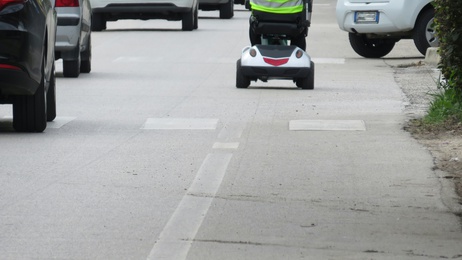Driving a mobility scooter on the road
If you’ve never owned a mobility scooter before or if you’re looking to update your current scooter, you may be wondering whether or not you can drive it on the road. We’ve put together the following guide to help.

If you have trouble walking or getting around, a mobility scooter can transform your day to day life. Offering a comfortable, quick and versatile way of travelling and the ability to go almost anywhere, mobility scooters enable you to retain your freedom and independence.
Mobility scooters and the Highway Code
Many new mobility scooter users may be unaware that they are categorised by law as a type of vehicle and as such are subject to certain rules. The type of mobility scooter or powered wheelchair you need will depend on where you want to use it and/or how far you need to travel.
Depending on its functionality, a mobility scooter or powered wheelchair is either ‘class 2’ or ‘class 3’ – class 2 scooters have a maximum speed of four miles per hour (mph) and cannot be used on the road, while class 3 scooters have a maximum speed of four mph off the road, and eight mph (12 km/h) on the road. Other features of class 3 mobility scooters are a maximum weight of 150kg (without a driver), a maximum width of 0.85 metres and an efficient braking system.
Because class 3 scooters can be taken on the road, they must be registered by their owners with the Driver and Vehicle Licensing Agency (DVLA) and cannot be driven by anyone under 14 years of age. However, as long as they have a device that limits them to four mph on the pavement, class 3 scooters are exempt from road tax.
If you have a class 3 scooter and you need to register it, you’ll need to complete form V55/4 for a new scooter, or form V55/5 for a used scooter, and return it to the DVLA. You can order your form here.
It’s also worth noting that while there aren’t specific legal requirements regarding eyesight that apply to mobility scooters, you should be able to read a car’s registration number from a distance of 12.3 metres or 40 feet.
Driving mobility scooters on the road
There are limits to where you can drive a class 3 scooter and remember, the maximum road speed is eight mph (12 km/h). A class 3 mobility scooter cannot be driven on motorways, bus lanes or ‘cycle-only’ lanes, and we do not recommend taking them on to dual carriageways with a speed limit of over 50mph. If you do drive them on a dual carriageway, make sure you have an amber flashing light for visibility.
You must always travel in the direction of traffic and as with any other vehicle used on the road, you must use your lights, indicators and horns according to the Highway Code. For the full list of Highway Code rules that apply to class 3 scooters, click here.
Class 2 scooters cannot be used on the road, unless there is no pavement and it cannot be avoided.
Driving mobility scooters on the pavement
Both class 2 and class 3 scooters can be used on the pavement at a maximum speed of four mph, but never on ‘cycle-only’ paths. When parking, never leave your scooter where it might be in the way of other pedestrians, including people with prams or pushchairs and wheelchair users.
If you’ve found this article helpful, don’t forget to read through our other guides for more information about mobility scooters and how they can make your life easier.